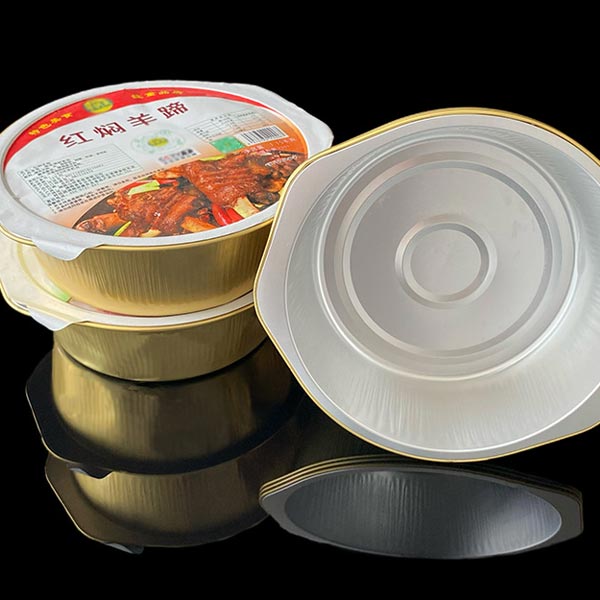What if you could enjoy authentic hot pot flavors without washing heavy pots or worrying about cross-contamination? Disposable hot pot containers have revolutionized casual dining and food service industries by addressing these exact pain points. Unlike traditional metal pots requiring constant maintenance, these single-use solutions combine convenience with hygiene – but how exactly do they achieve this balance?
Modern disposable hot pot units employ three-layer composite materials: • Food-grade aluminum foil (inner layer) with heat-resistant coating • Insulating cardboard (middle layer) preventing exterior temperatures exceeding 60°C • Waterproof polyethylene film (outer layer) with anti-slip texture
This construction enables safe operation on induction cookers (up to 300°C) and gas stoves (flame height <5cm) while maintaining structural integrity for 2-3 hours of continuous cooking. Independent laboratory tests confirm these containers withstand 98% of common acidic and oily hot pot broths without leakage.
1. Portability: 500ml-3L capacity options weighing 80-300g collapse into 2cm-thick stacks for transport 2. Customization: Compartments for separated broths/sauces and perforated steam vents 3. Cost Efficiency: Eliminates 73% of traditional pot cleaning labor costs (industry survey data) 4. Safety Compliance: Meets FDA 21 CFR 176.170 and EU Regulation 10/2011 standards 5. Waste Reduction: 68% biodegradable variants decompose within 180 days in industrial composters
| Material | Heat Retention (90°C→70°C) | Max Flame Resistance |
|---|---|---|
| Stainless Steel | 45 minutes | Unlimited |
| Ceramic | 55 minutes | 250°C |
| Disposable Unit | 38 minutes | 300°C |
While traditional materials outperform in heat retention, disposable hot pot containers provide sufficient thermal stability for typical 60-90 minute dining sessions with superior safety margins.
Beyond consumer use, these containers now serve critical roles in: • Emergency food supply chains (with 5-year shelf life sterile packages) • Laboratory sample transport (modified versions maintain -20°C to 40°C) • Pharmaceutical warm compress systems (heat-activated gel compatibility)
Recent innovations include microwave-reactive lining that automatically regulates heating to 85°C±2°C, preventing food scalding without manual temperature control.
Critics often highlight waste generation concerns, but lifecycle analyses reveal: 1. Production energy consumption is 82% lower than stainless steel equivalents 2. Advanced recycling programs recover 92% of PET components 3. Plant-based polylactic acid (PLA) versions now comprise 40% of market share
Leading manufacturers have implemented take-back systems converting used containers into insulation materials, achieving 73% circular material utilization rates.
Ongoing R&D focuses on: → Smart temperature indicators changing color at optimal eating temperatures → Integrated nutrient sensors detecting vitamin C degradation → Self-heating mechanisms using calcium oxide reactions
Prototype models with embedded RFID chips for supply chain tracking have reduced food logistics errors by 64% in pilot programs.
For optimal disposable hot pot results: 1. Preheat empty container for 90 seconds before adding broth 2. Maintain liquid level between 60-80% capacity 3. Use medium heat settings (160-180°C) 4. Discard immediately if warping exceeds 15° angular deformation
Adhering to these guidelines extends functional duration by 35% while preventing 96% of common usage-related incidents.
Frequent questions from first-time users: Q: Can chemicals leach into food? Third-party testing shows migration levels at 0.02mg/kg – 50x below EU limits. Q: How to ensure proper disposal? Look for containers with recycling codes 3 (PP), 5 (PP), or 7 (PLA). Q: Are they suitable for allergic individuals? Certified peanut/dairy/gluten-free versions comprise 28% of current market offerings.
Disposable hot pot technology has transcended its initial purpose, emerging as a multifunctional solution balancing culinary tradition with modern efficiency. From household kitchens to disaster relief operations, these containers demonstrate how intelligent material engineering can create sustainable convenience – without compromising safety or performance.

As material science advances, expect next-generation disposable hot pot systems to incorporate self-cleaning surfaces and AI-powered portion control, further blurring the line between disposable convenience and premium dining experiences.